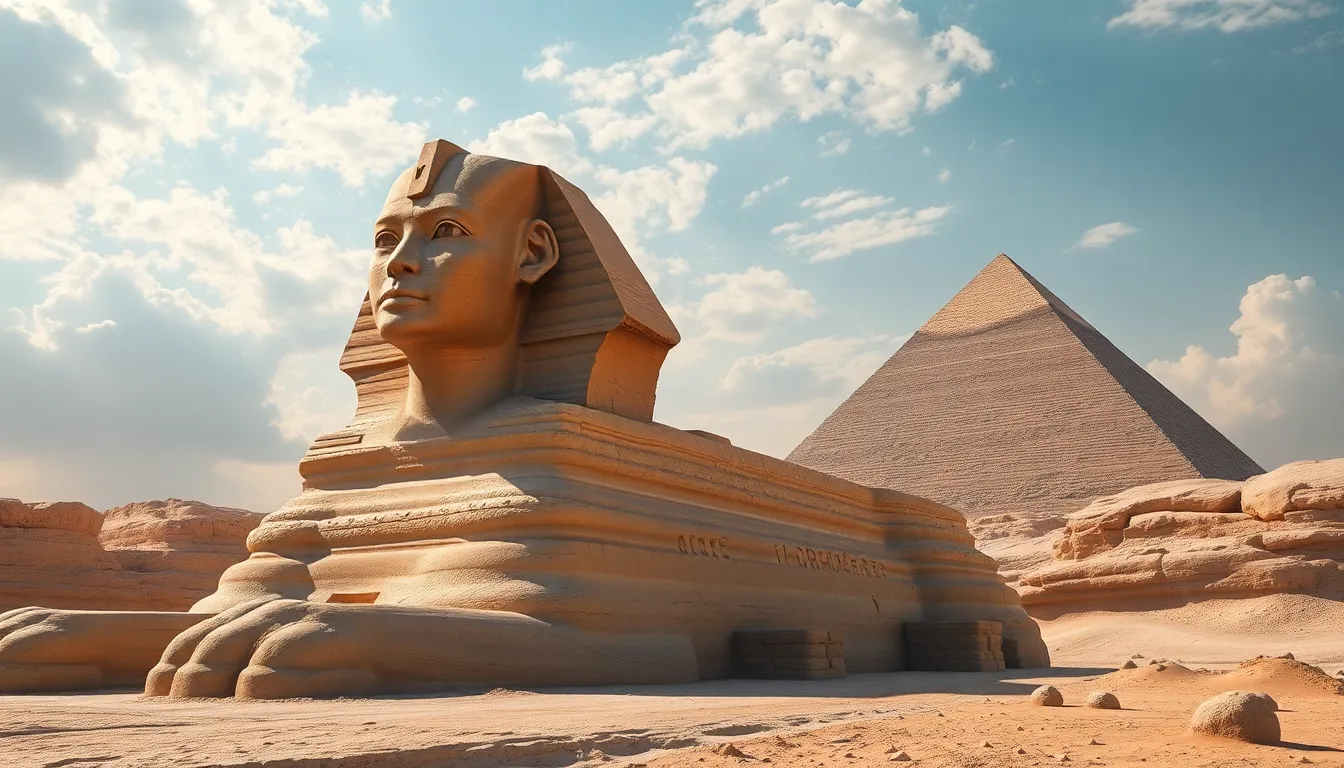The Myths Surrounding Pharaoh Khafre and the Sphinx
I. Introduction
Pharaoh Khafre, a prominent ruler of ancient Egypt, reigned during the Fourth Dynasty of the Old Kingdom, approximately around 2570 BC. He is best known for his monumental contributions to Egyptian architecture, notably the construction of the second pyramid at Giza, which is part of a larger complex that includes the Great Sphinx. The Sphinx, a colossal limestone statue with the body of a lion and a human head, has intrigued historians, archaeologists, and tourists alike for centuries.
This article aims to debunk various myths surrounding Pharaoh Khafre and the Great Sphinx, while also examining the historical truths that underpin these fascinating subjects. By separating fact from fiction, we hope to contribute to a clearer understanding of ancient Egyptian civilization.
II. The Historical Context of Pharaoh Khafre
Khafre ascended to the throne as the fourth pharaoh of the Fourth Dynasty, following his father, Sneferu. His reign is marked by significant achievements, including:
- The construction of the Great Pyramid of Khafre, which stands at a height of approximately 136.4 meters (448 feet).
- The establishment of large-scale building projects, which included temples and mortuary structures.
- Advancements in art and culture, reflected in the exquisite craftsmanship of statues and reliefs from his time.
Khafre’s pyramid complex, located at Giza, includes not only his pyramid but also the Great Sphinx, which is thought to serve a critical role in the funerary practices of the time. His lineage is significant, as he is believed to be the son of Khufu, the builder of the Great Pyramid, and the brother of Djedefre.
III. The Great Sphinx: An Icon of Ancient Egypt
The Great Sphinx of Giza is one of the largest and oldest statues in the world, measuring 73 meters (240 feet) long and 20 meters (66 feet) high. Its architectural significance lies not only in its sheer size but also in its intricate design, which reflects the advanced engineering skills of the ancient Egyptians.
Various theories regarding the construction and purpose of the Sphinx have been proposed, including:
- It was built as a guardian of the Giza plateau.
- It served as a representation of royal power, embodying the pharaoh’s connection to the divine.
- It was part of a larger religious complex designed to honor the sun god Ra.
The relationship between the Sphinx and Khafre’s pyramid is evident through the alignment of their structures, suggesting that the Sphinx was intentionally placed to watch over Khafre’s tomb.
IV. Myth 1: The Sphinx as Khafre’s Guardian
One of the most enduring beliefs is that the Great Sphinx was constructed to protect Khafre’s tomb. This myth is deeply rooted in the cultural significance of guardianship in ancient Egyptian beliefs, where deities and statues often served as protectors of the deceased.
However, archaeological evidence presents a more complex picture. While the Sphinx is located near Khafre’s pyramid, there is no definitive inscription or historical record linking the Sphinx directly as a guardian of his tomb. Instead, it may have served a more symbolic role in the broader context of the Giza necropolis.
V. Myth 2: The Sphinx’s Features and Identity
Another myth asserts that the Sphinx represents Pharaoh Khafre himself. This belief is often supported by the resemblance of the Sphinx’s features to those of Khafre’s statues found in his mortuary temple.
However, alternative theories suggest that the Sphinx may represent other deities or concepts, such as:
- The sun god Ra, with the lion’s body symbolizing strength and power.
- Horus, representing the pharaoh’s divine right to rule.
The iconography of the Sphinx in relation to other deities reveals a rich tapestry of meanings that transcend the idea of it being solely a representation of Khafre.
VI. Myth 3: The Age and Origins of the Sphinx
Common misconceptions about the Sphinx’s age and the identity of its builders have persisted throughout history. Many believe that the Sphinx was constructed around the same time as Khafre’s pyramid, but modern archaeological research suggests a different timeline.
Recent findings indicate that:
- The Sphinx may predate Khafre and could have been built during the reign of Khufu or even earlier.
- There are ongoing debates regarding the methods of construction and the workforce involved, with some scholars suggesting that it was built by skilled laborers rather than slaves.
This ongoing research continues to shed light on the origins and age of the Sphinx, complicating the narrative surrounding its historical timeline.
VII. The Sphinx in Popular Culture
The myths surrounding Khafre and the Sphinx have significantly influenced literature, film, and popular culture. From ancient texts to contemporary movies, these myths shape public perception of ancient Egypt.
This influence manifests in various ways:
- Books and films often portray the Sphinx as a mystical guardian of secrets and treasures.
- Documentaries and fictional accounts sensationalize its history, often prioritizing entertainment over historical accuracy.
Such sensationalism can lead to misunderstandings and a skewed perception of ancient Egyptian civilization, highlighting the importance of grounding popular narratives in factual historical research.
VIII. Conclusion
In summary, the myths surrounding Pharaoh Khafre and the Great Sphinx are rich and varied, reflecting the complexities of ancient Egyptian beliefs and the historical context of the time. By addressing key myths, including the Sphinx’s role as a guardian, its identity, and its age, we can better appreciate the true nature of these iconic symbols.
Distinguishing fact from fiction is essential in understanding history, and continued exploration and study of ancient Egyptian civilization will only enhance our knowledge of this remarkable culture. We encourage further inquiry into the fascinating world of ancient Egypt, where every stone tells a story.




